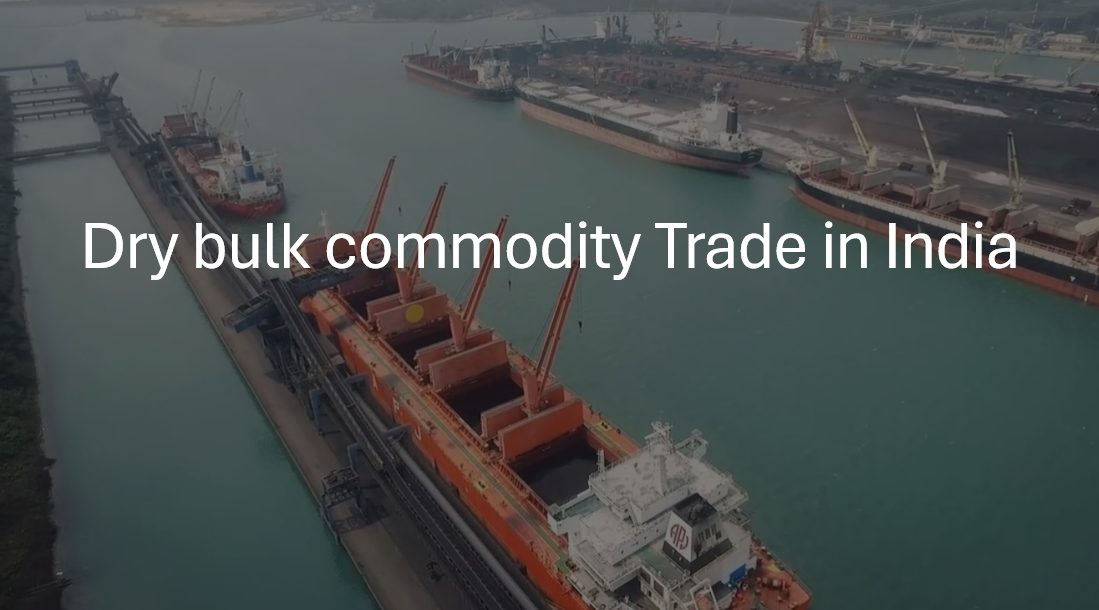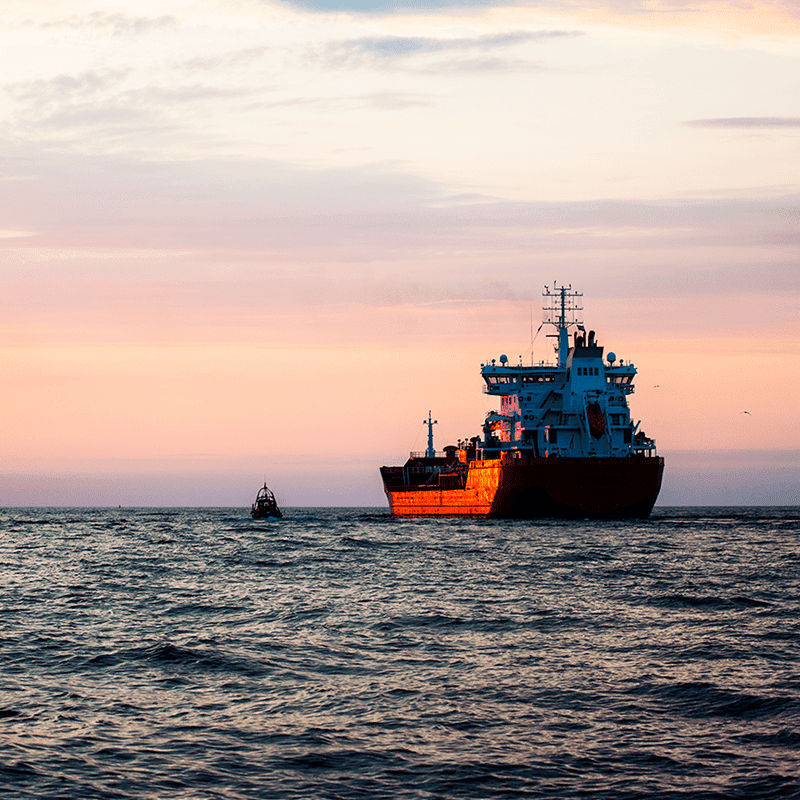BLOG
Dry bulk commodity Trade in India (Updated in 2025)
- General Shipping
- Market Analysis
2025.07.07
In continuation of the article “Dry Bulk Commodity Trade in India” published earlier, which explored key trends and prospects of India's dry bulk commodity trade, this second part further analyzes India’s recent trade pattern, developments related to Indian ports and the growth of country’s shipbuilding and scrap industries.
Key Points
- Global volume is projected to rise 5% to 5.5 billion tons in 2024, up from 3% growth last year.
-
India, the world’s second largest importer, handles 367 million metric tons, with coal and limestone imports rising steadily.
-
India’s dry bulk market continues to expand, driven by GDP growth and government support, and is emerging as a key manufacturing and transport hub post-U.S.-China trade tensions.
-
The Indian government is advancing port, shipbuilding, and eco-friendly ship recycling initiatives.
Global Dry Bulk Trade Trends in 2024
In 2024, global dry bulk vessel trade grew by 5.3%, increasing from 5,206 MMT (Million Metric Tons) to 5,480 MMT. This marks a significant improvement compared to the 2.5% growth recorded in the previous year.
Import Trends:
ASEAN5 countries experienced a significant trade expansion of 14.9%. China and India recorded moderate import growth rates of 5.7% and 2.8%, respectively. In contrast, Japan and the United States saw declines in dry bulk imports, with decreases of 1.8% and 4.2%.
Export Trends:
As a country with a large growth rate, Argentina’s export volume jumped 47.6%, returning to 2022 levels. China rose 27% to 215 MMT from 169 MMT. Guinea grew 15.1%, while India held steady at 85 MMT. Japan edged up from 53 to 58 MMT, and the U.S. rose 10.5% to 311 MMT. Ukraine has notably resumed dry bulk exports reaching 61 MMT after war-related disruptions.
Dry Bulk Trade – India’s growth rate in recent years
In 2024, India’s dry bulk trade exhibited signs of moderation & stabilization after the fluctuations of previous years.
According to data provided by AXSMarine,
- ・Imports grew modestly by +2.8%, following two years of strong growth, indicating steady domestic demand.
- ・Exports contracted slightly by -0.5%, suggesting a normalization in international trade volumes after a robust rebound of +13.6% in 2023.
This mixed trend highlights a mature phase for India’s dry bulk trade, where growth rates are stabilizing amid evolving global market dynamics, softer commodity demand.
%20growth%20rate%25.jpg?width=679&height=303&name=Indias%20Drybulk%20Trade%20(Import)%20growth%20rate%25.jpg)
%20growth%20rate%25.jpg?width=686&height=308&name=Indias%20Drybulk%20Trade%20(Exmport)%20growth%20rate%25.jpg) (Data Source: AXSMarine)
(Data Source: AXSMarine)
Dry Bulk Global Trade: Import rankings in recent years
India overtook Japan in 2023 to become the second-largest importer of dry bulk commodities, maintaining this position in 2024 with 367 million MT. This reflects India’s growing industrial demand and strategic importance in global maritime trade dynamics.
%20(2).jpg?width=751&height=319&name=Import%20Country%20Ranking%20(In%20MMT)%20(2).jpg) (Data Source: AXSMarine)
(Data Source: AXSMarine)
Dry Bulk Global Trade: Export rankings in recent years
India’s slight downgrade in export ranking to 11th in 2024, despite maintaining a near-consistent export volume of 85 million MT in year 2024, reflects intensifying global competition, especially from countries like Vietnam.
A modest dip of 1 MMT in 2024 caused India to fall behind Vietnam, who reached 91 MMT.
%20(2).jpg?width=751&height=323&name=Export%20Country%20Ranking%20(In%20MMT)%20(2).jpg)
(Data Source: AXSMarine)
India’s Dry bulk commodity trade – Iron Ore:
In 2023, India witnessed remarkable growth in iron ore trade, with exports surging by 164.3% and imports increasing by 137.3%, marking a year of exceptional activity. However, in 2024, iron ore exports declined by 17.5%, falling from 44 MMT to 36 MMT, likely reflecting a market correction after the previous year’s spike. Imports remained stable at around 5 MMT, suggesting a phase of stabilization or saturation in import dependency.


(Data Source: AXSMarine)
India’s Dry bulk commodity trade
– Steaming coal & Coking coal:
India is primarily an importing country for coal (both steam and coking), with minimal export volumes. In 2024, India’s steam coal imports declined slightly by 5.1%, returning close to the 2022 level, with a total volume of 163 MMT. However, coking coal saw steady growth of 6.8% in 2024, reaching a total volume of 72 MMT. India primarily imports steam coal from Indonesia, South Africa, the USA, and Russia, while coking coal is mainly sourced from Australia, Russia, the USA, and South Africa. In 2024, a notable increase of approximately 3 MMT (22%) was observed in coking coal imports from Russia.


(Data Source: AXSMarine)
India’s Dry bulk commodity trade – Bauxite:
India's import of bauxite has increased recently. In 2023, bauxite imports 3.6 million metric tons, marking a 3.4% year-over-year increase. This trend continued into 2024, with imports rising by 30.5% to 4.7 MMT. The surge in imports is driven by the growing demand in India's aluminum sector, which is expanding rapidly due to its applications in construction, automotive and electronics.
 (Data Source: AXSMarine)
(Data Source: AXSMarine)
India’s Dry bulk commodity trade – Limestone:
India's import of limestone has increased significantly in recent years. In 2024, limestone imports reached approximately 32 million metric tons, accounting for 55% of the total volume of major mineral imports. This represents a substantial rise of 13.6% year-over-year.
The increase in limestone imports is driven by the growing demand from various industries, including steel, cement and chemicals. Despite having substantial domestic limestone resources, India relies on imports to meet the high demand and ensure the quality required for industrial applications.

(Data Source: AXSMarine)
India’s Dry bulk commodity trade – Salt:
India's salt exports saw a huge increase in Year 2024, reaching 17.6 million metric tons, which is a 65.5% increase compared to the previous year.
There was a notable rise in demand for industrial salt, especially from Far East countries like China, South Korea and Japan. Gujarat, the leading salt-producing state accounting for over 75% of India’s output, experienced an exceptionally productive year. Favorable weather conditions combined with expanded production capacity helped boost output.
.jpg?width=824&height=371&name=Salt%20Export%20growth%20in%20India%20(1).jpg)
(Data Source: AXSMarine)
India’s Dry bulk commodity trade – Vessel size wise:
Large vessels like Capesize, Panamax are primarily used for importing commodities like Iron Ore, Coal. However, Capesize vessels are less commonly used in India due to draft restrictions at most ports. They are mainly deployed at deep-draft ports like Mormugao (Goa) and Gangavaram (Visakhapatnam). India's dry bulk imports are predominantly handled by Panamax and Handymax vessels, which offer an optimal balance between cargo capacity and port accessibility.
On export front, Handymax vessels account for the majority share at 65.8%. The share of Capesize vessels has declined significantly from 3.9% in 2023 to just 1.4% largely due to the reduction in iron ore exports.

.jpg?width=899&height=407&name=Export%20from%20India%20Vessel%20size%20wise%20(1).jpg) (Data Source: AXSMarine)
(Data Source: AXSMarine)
Indian Ports: Recent Developments
The Indian government has recently launched several transformative policies focused on modernizing and expanding the nation’s port infrastructure. Below are the key highlights:
□Maritime Development Fund (MDF)
- ・Designed to offer long-term, affordable financing to support the modernization of ports, advancement of shipbuilding and development of logistics infrastructure.
- ・Promotes increased private sector involvement and fosters public-private partnerships to enhance maritime capabilities.
□"One Nation – One Port" (ONOP) Initiative
- ・A unified approach aimed at standardizing and harmonizing operations across all major ports in India.
- ・Targets the elimination of inefficiencies in documentation and logistics to minimize costs and reduce delays.
□The Sagar Aankalan - Logistics Port Performance Index (LPPI) launched on February 27, 2025, by Ministry of Ports, Shipping and Waterways, aligns with the PM Gati Shakti National Master Plan and National Logistics Policy to benchmark port performance, enhance efficiency and strengthen India's trade connectivity.
India’s Shipbuilding Industry
India's shipbuilding industry has seen a significant strategic push in 2024–2025, driven by government initiatives aimed at revitalizing the sector and reducing dependence on foreign-built vessels. Below are the key highlights:
□Maritime Development Fund (MDF) - A Game Changer
- ・Provide long-term, affordable financing to Indian shipyards.
- ・Promote green shipping by supporting energy-efficient and eco-friendly vessels.
- ・Reduce India's foreign shipping dependence, aiming to increase its share in global shipping tonnage from 2% to 5% by 2030
□Infrastructure and Policy Support
- ・Shipbuilding Financial Assistance Policy (2016–2026): Offers up to 20% subsidies on shipbuilding contracts.
- ・Infrastructure status for vessels: Announced in Budget 2025, allows easier access to financing and tax benefits.
There are 28 shipyards in the country, comprising 6 under the Central Public Sector, 2 under State Governments, and 20 operated by Private Sector Undertakings. Major public sector players include Cochin Shipyard Ltd. (CSL) and Mazagon Dock Shipbuilders Ltd. (MDL), while key private players are L&T Shipbuilding and Reliance Naval & Engineering Ltd.
Ship Recycle Industry
The ship recycling industry - also known as ship breaking, ship scrapping or ship dismantling - is the process of deconstructing old ships to recover valuable materials and components.
□Major Ship Recycle countries are
・Bangladesh
・Pakistan
・Turkey
- ・India takes one of major share approximately 20-30% (33% in 2023) in global ships dismantled each year.
- ・Alang-Sosiya in Gujarat is known as one of the largest ship recycling clusters.
- ・The ship recycling industry plays a crucial role in supplying steel scrap and other reusable materials, supporting India's economy and steel production.
- ・The steel generated from ships is recycled to recycle-steel using electric arc furnaces (EAF). This contributes to the reduction of environmental impact compared to steel production using blast furnaces and for sustainable society.
- ・On the other hand, the industry still have environmental protection and safety concerns remained, need to address further sustainable management and operation in terms of human rights, including environment protection and ensuring the safety of workers.
- ・"The Recycling of Ships Act, 2019" has been implemented as a domestic legislation to ensure international standards for safe and environmentally sound recycling of ships.
- ・1.3-1.5 million GT ship demolition was estimated in India 2024, and significant increase could be expected in near future, depends in situation such as shipping market, ship recycling yards facility compliant in other ship recycling clusters.
Outlook for India's Dry Bulk Shipping Sector
India's prospects in the dry bulk shipping sector are showing cautious optimism, supported by several macroeconomic and geopolitical trends.
Stable GDP Growth:
India is projected to maintain strong GDP growth, with estimates around 6.3% in 2025, driven by domestic consumption, infrastructure investment and manufacturing expansion.
Government Policy Support:
Initiatives like Sagarmala and PM Gati Shakti aim to modernize ports, improve logistics, and reduce turnaround times.
US-China Trade War:
Ongoing tensions between the US and China are prompting supply chain diversification. India may emerge as an alternative manufacturing and export hub, potentially increasing dry bulk trade volumes.
 (Data Source: S&P Global)
(Data Source: S&P Global)


Writer:Pulak Ranjan Nath, Principal Data Analyst, MOL-IT India
Hello, I'm Pulak Ranjan Nath, a Principal Data Analyst at MOL-IT India, and a member of the Artificial Intelligence and Data Science (AID) team. With over 15 years at MOL-IT, I bring extensive experience in data analytics, particularly in the shipping domain. Currently, I am contributing to the Dry Bulk BI Project, where I explore Dry bulk shipping market data, generate meaningful business insights, and define key correlations. Additionally, I am involved in the Environment and Sustainability project, focusing on analytics related to CO2 emissions, CII ratings, and the EU ETS. As a Computer Science engineer and a Certified BI Professional, I am dedicated to leveraging data to drive innovation and sustainability in our business.
Recommended Articles
2022.07.05
- General Shipping
2021.04.13
- Energy
2023.12.19
- General Shipping
2021.08.07
- Eco Friendly
2025.03.18
- General Shipping
Latest Articles
2025.12.09
- Eco Friendly
- General Shipping
2025.12.03
- General Shipping
2025.11.20
- Energy
- General Shipping








